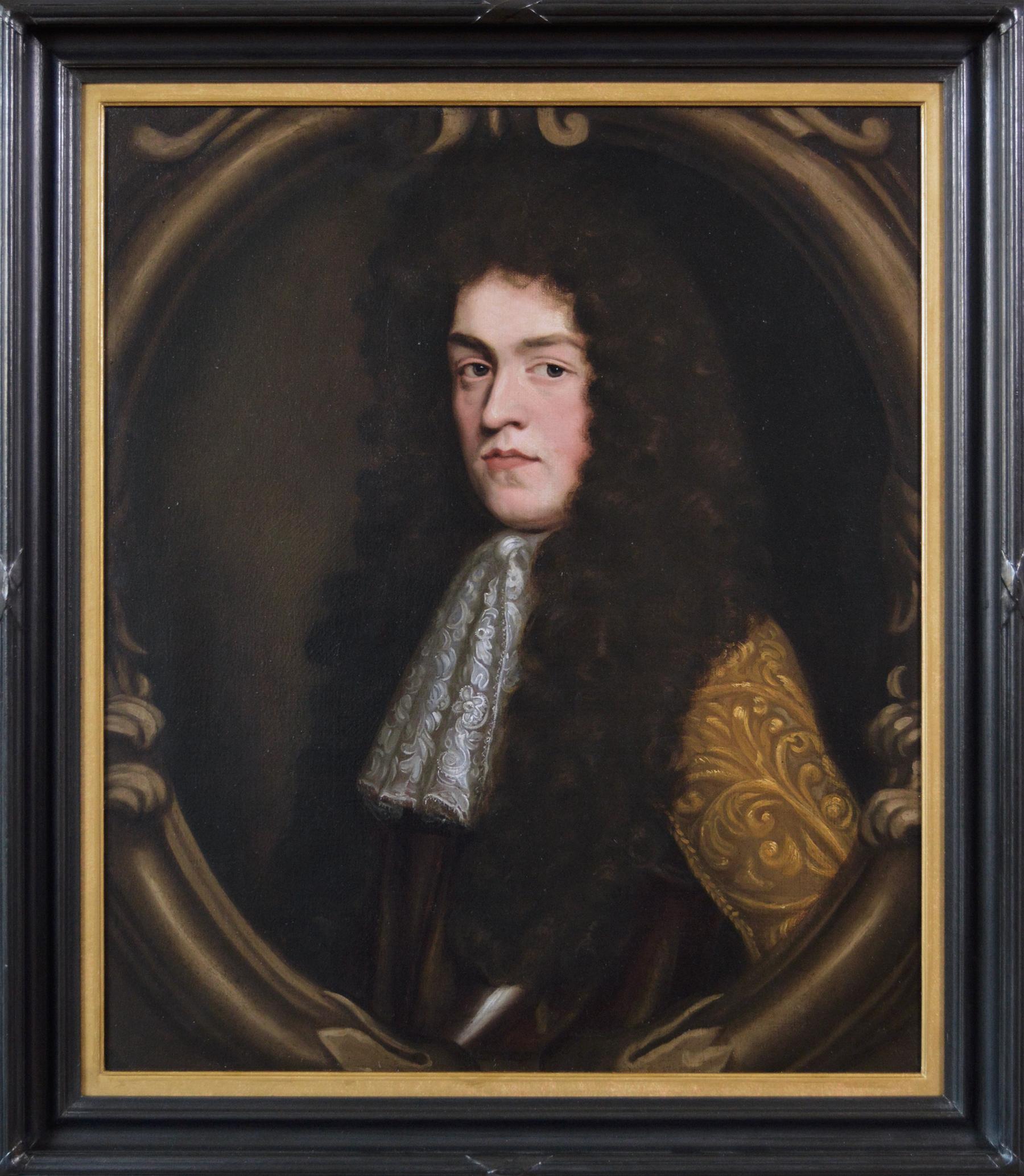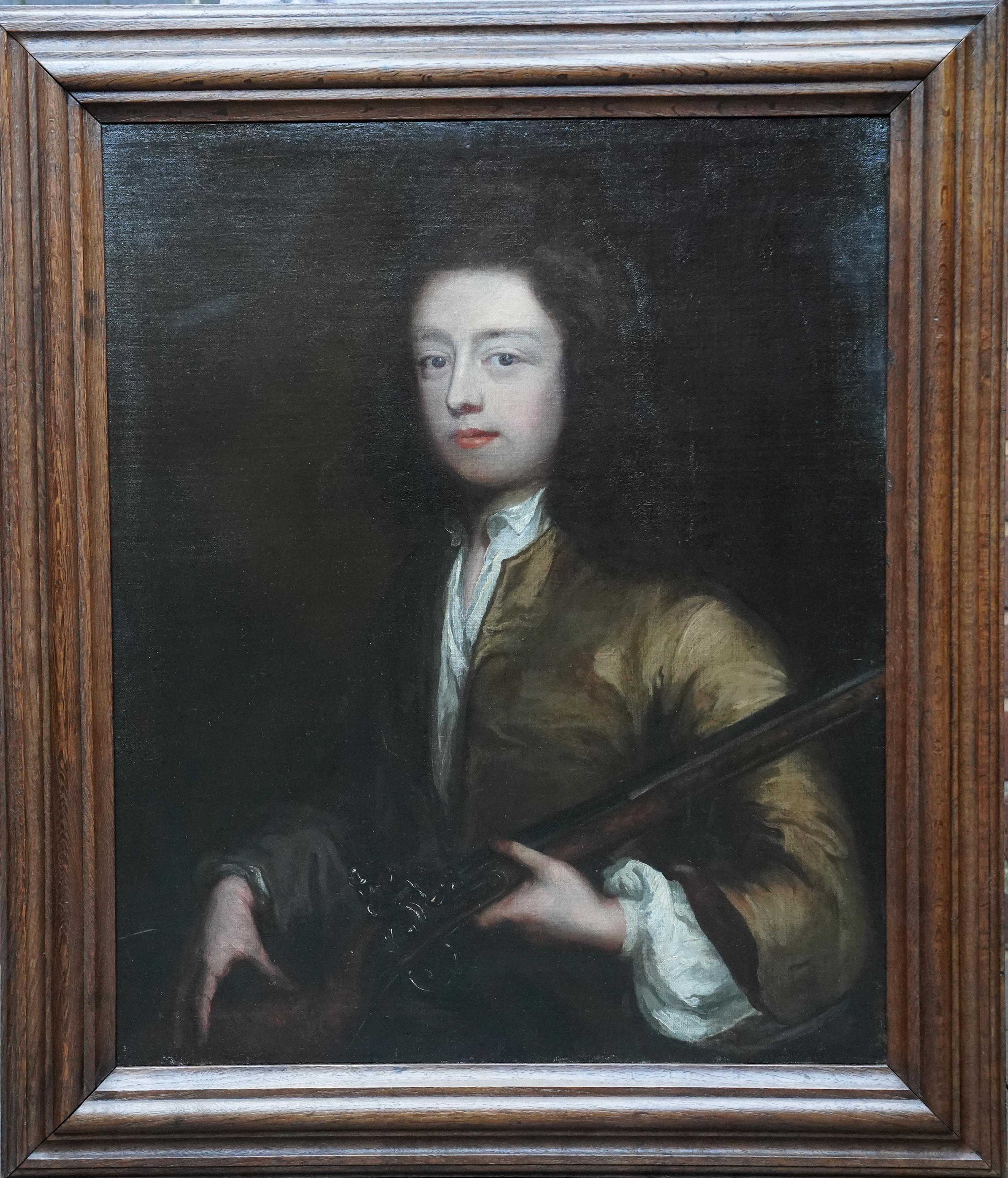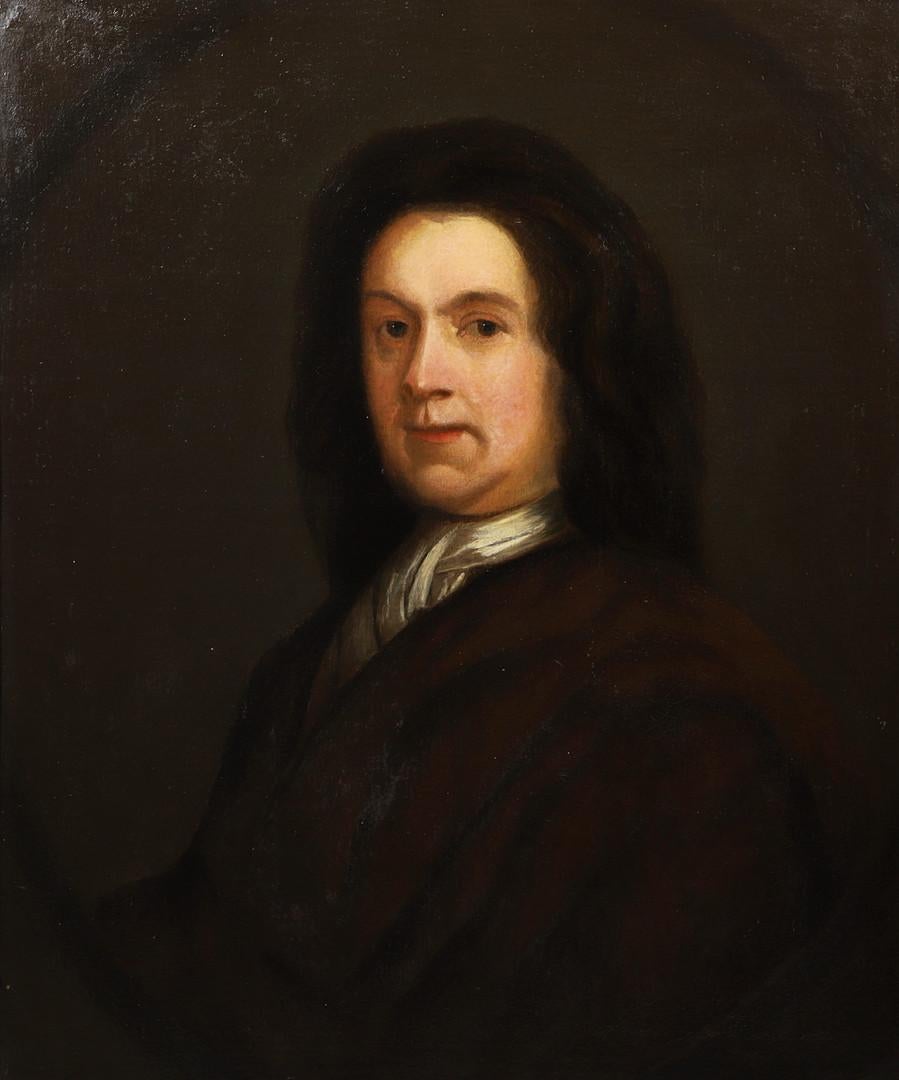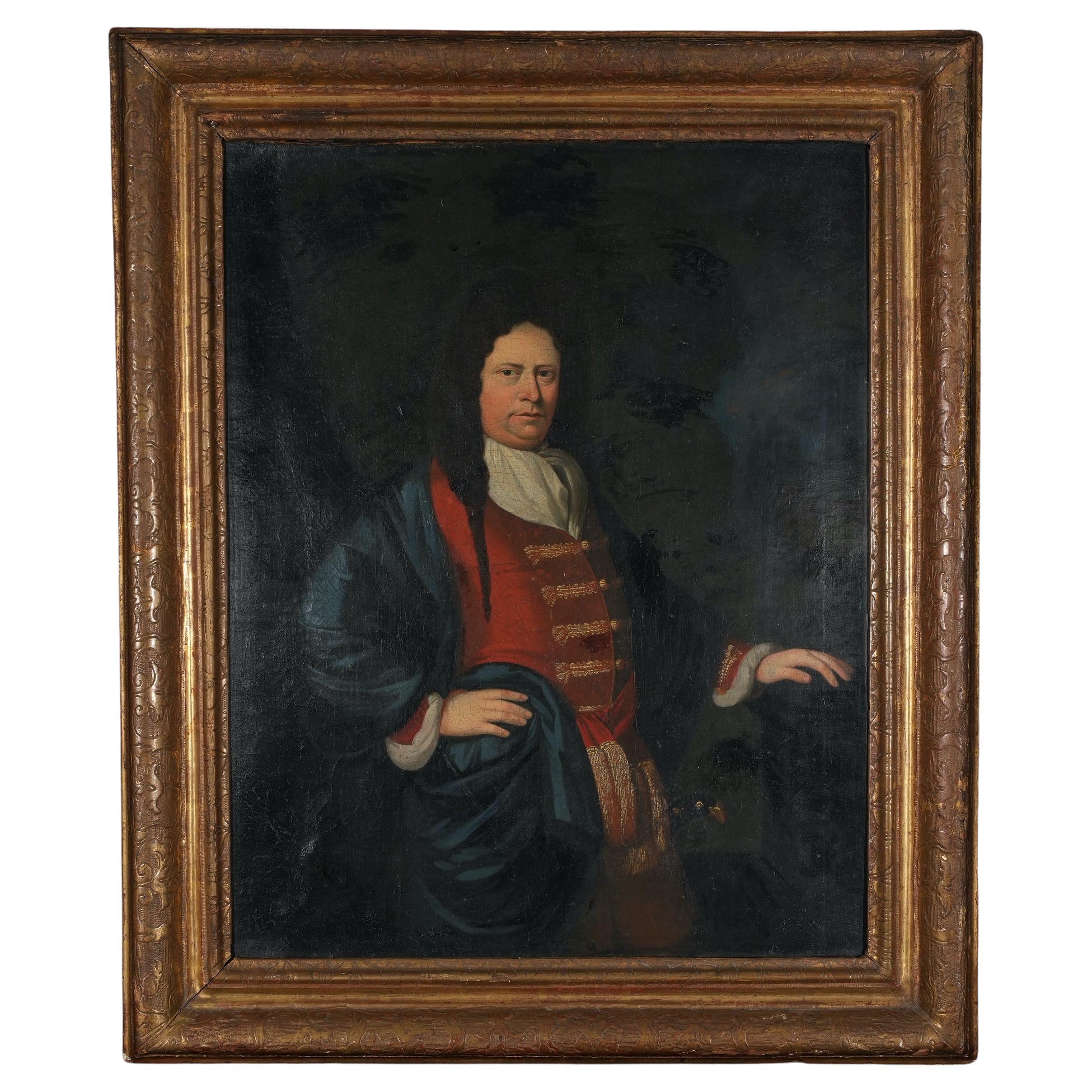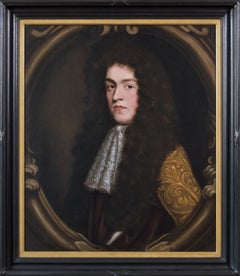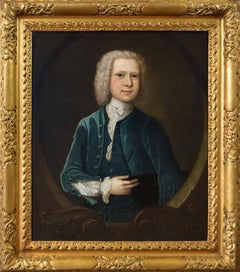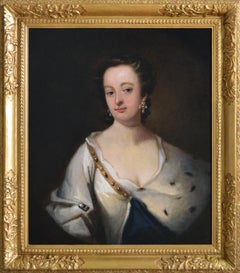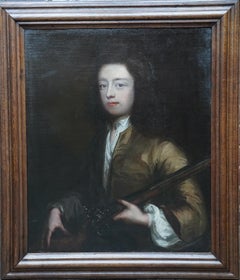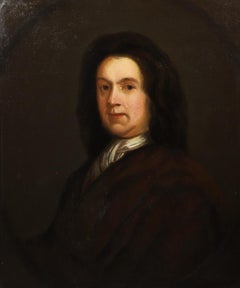Items Similar to 17th Century portrait oil painting of a gentleman
Want more images or videos?
Request additional images or videos from the seller
1 of 13
17th Century portrait oil painting of a gentlemanC1690
C1690
$6,880.54
£4,950
€5,834.18
CA$9,353.93
A$10,477.61
CHF 5,447.19
MX$129,377.35
NOK 69,392.92
SEK 65,600.21
DKK 43,537.84
Shipping
Retrieving quote...The 1stDibs Promise:
Authenticity Guarantee,
Money-Back Guarantee,
24-Hour Cancellation
About the Item
Circle of John Riley
British, (1646-1691)
Portrait of a Gentleman
Oil on canvas
Image size: 29 inches x 24 inches
Size including frame: 36 inches x 31 inches
A fine half-length portrait of a gentleman set in a feigned stone oval, C1690, circle of John Riley. The sitter wears a lace jabot over a velvet jacket and is posed in a long dark wig, which was highly fashionable at the time. His bearing and pose indicate this is a gentleman of some standing and has been executed by an artist of great ability who has been influenced by John Riley.
John Riley or Ryley was born in London in 1646 the son of William Ryley, Lancaster Herald and keeper of the records in the Tower of London. He studied painting under Isaac Fuller and Gerard Soest and began earning his living painting portraits of courtiers and the nobility.
After the death of Sir Peter Lely he became one of the leading portrait painters of the day, gaining commissions from King Charles II and James II to paint portraits. He was later appointed Principal Painter in Ordinary, jointly with Sir Godfrey Kneller, to King William and Queen Mary. One of his pupils was Jonathan Richardson (1667–1745) who later married his niece. Riley died in 1691, and was buried in the church of St Botolph in Bishopsgate.
His work is held by a number of public collections including the Ashmolean Museum, Birmingham Museum, Bodleian Library, Christchurch College, Cromwell Museum, English Heritage, National Portrait Gallery, National Trust, Traquair House and Walker Art Gallery.
Presentation: The painting is housed in a period ebonised and gilt frame which is in excellent condition.
Condition: As with all of our original antique oil paintings, this work is offered in ready to hang gallery condition, having been professionally cleaned, restored and revarnished.
© Benton Fine Art
- Creation Year:C1690
- Dimensions:Height: 36 in (91.44 cm)Width: 31 in (78.74 cm)Depth: 2 in (5.08 cm)
- Medium:
- Movement & Style:
- Circle Of:John Riley (1646 - 1691, English)
- Period:
- Condition:
- Gallery Location:Nr Broadway, GB
- Reference Number:1stDibs: LU15628895052
About the Seller
5.0
Platinum Seller
Premium sellers with a 4.7+ rating and 24-hour response times
Established in 1972
1stDibs seller since 2015
332 sales on 1stDibs
Typical response time: <1 hour
Associations
The British Antique Dealers' AssociationLAPADA - The Association of Arts & Antiques DealersInternational Confederation of Art and Antique Dealers' Associations
- ShippingRetrieving quote...Shipping from: Nr Broadway, United Kingdom
- Return Policy
Authenticity Guarantee
In the unlikely event there’s an issue with an item’s authenticity, contact us within 1 year for a full refund. DetailsMoney-Back Guarantee
If your item is not as described, is damaged in transit, or does not arrive, contact us within 7 days for a full refund. Details24-Hour Cancellation
You have a 24-hour grace period in which to reconsider your purchase, with no questions asked.Vetted Professional Sellers
Our world-class sellers must adhere to strict standards for service and quality, maintaining the integrity of our listings.Price-Match Guarantee
If you find that a seller listed the same item for a lower price elsewhere, we’ll match it.Trusted Global Delivery
Our best-in-class carrier network provides specialized shipping options worldwide, including custom delivery.More From This Seller
View All17th Century portrait oil painting of a gentleman
By Willem Wissing
Located in Nr Broadway, Worcestershire
Circle of Willem Wissing
Dutch, (1656-1687)
Portrait of a Gentleman
Oil on canvas
Image size: 29 inches x 24.5 inches
Size including frame: 35 inches x...
Category
17th Century Portrait Paintings
Materials
Canvas, Oil
18th Century portrait oil painting of a gentleman
Located in Nr Broadway, Worcestershire
Follower of Enoch Seeman the Younger
German, (1694-1744)
Portrait of Gilbert Sympkin
Oil on canvas
Image size: 29.25 inches x 24.5 inches
Size including frame: 38 inches x 33.25 inches
A fine three quarter length portrait of a gentleman traditionally identified as Gilbert Simpkin (Sympkin), follower of Enoch Seeman the younger, C1720. The portrait is set in a feigned sculptured oval cartouche, a device used to give a sense of depth. The sitter is depicted wearing a fashionable blue jacket and matching waistcoat with a white chemise and lace jabot. He wears a powdered wig in the fashionable style of the day and is posed holding his hat under his left arm with the fingers of his right hand stretched out. At court, long fingers signified wealth, culture and intelligence. The painting has clearly been executed by an artist of great ability who has been influenced by Enoch Seeman the younger.
Gilbert Simpkin (Sympkin) was born in London on 24 August 1683, the son of John Simpkin and Susannah Butler. His grandfather was also called Gilbert Simpkin. He entered Oxford University in 1700 where he studied at St John’s College. In 1702, he became a student of Middle Temple, which at the time was one of the world’s most important centres of legal education. He later settled in Plymouth and then Bristol. He died in Bristol on 15 May, 1744 and was buried at Bristol Cathedral. He remained unmarried and the portrait may well have been commissioned to commemorate when he was first Called to the Bar or perhaps had established his own practice.
Enoch Seeman or Seemann the younger was born in Danzig, Germany now Gdansk, Poland in 1694. His father was Enoch Seeman Senior, an artist of Flemish origin and his brothers Isaac, Noah and Abraham also became artists. He came to London with his father and brothers around 1704 and established himself as a portrait artist. From 1717 he became painter to the Royal court painting...
Category
18th Century Old Masters Portrait Paintings
Materials
Canvas, Oil
17th Century portrait oil painting of a lady
Located in Nr Broadway, Worcestershire
Circle of Sir Peter Lely
Dutch, (1618-1680)
Portrait of a Lady, traditionally identified as Princess Henrietta Anne Stuart
Oil on canvas
Image...
Category
17th Century Portrait Paintings
Materials
Canvas, Oil
18th Century portrait oil painting of a lady in an ermine trimmed cloak
By Sir Godfrey Kneller
Located in Nr Broadway, Worcestershire
Circle of Sir Godfrey Kneller
Dutch, (1646-1723)
Portrait of a Lady in an Ermine Trimmed Cloak
Oil on canvas
Image size: 26.5 inches x 22.5 inches
Size including frame: 33.5 inches x 29.5 inches
A well-executed half-length portrait of a lady painted in a feigned oval, circle of Sir Godfrey Kneller. The use of a feigned oval was a device used in portraiture to give a sense of depth and add an intimacy to the painting, drawing your attention to the sitter.
The subject, posed without her wig in the undressed fashion of the day, wears a blue ermine trimmed blue cloak over a white silk robe...
Category
18th Century Old Masters Portrait Paintings
Materials
Canvas, Oil
17th Century portrait oil painting of a lady
By Studio of Sir Peter Lely
Located in Nr Broadway, Worcestershire
Studio of Sir Peter Lely
Dutch, (1618-1680)
Portrait of a Lady
Oil on canvas
Image size: 29.25 inches x 24.25 inches
Size including frame: 37...
Category
17th Century Portrait Paintings
Materials
Canvas, Oil
18th Century portrait oil painting of a girl with an orange
By Robert Byng
Located in Nr Broadway, Worcestershire
Circle of Robert Byng
British, (1666-1720)
Girl with Orange
Oil on canvas
Image size: 29 inches x 24 inches
Size including frame: 36 inches x 31 inc...
Category
18th Century Old Masters Portrait Paintings
Materials
Canvas, Oil
You May Also Like
English 17th century portrait of John Ludford Esquire
By Mary Beale
Located in Bath, Somerset
Portrait of John Ludford (1653-1681), wearing a lace jabot and brown and gold trimmed cloak in a feigned stone oval cartouche. Inscribed 'John Ludford, Esq, nat. 14th March 1653, Ob,...
Category
Late 17th Century Baroque Portrait Paintings
Materials
Canvas, Oil
$12,232 Sale Price
20% Off
Old Master Portrait of a Gentleman - British 18th century oil painting
By Michael Dahl
Located in London, GB
This stunning 18th century Old Master portrait oil painting is attributed to Swedish born, England based artist Michael Dahl. Painted circa 1690 it is a sumptuous half length portrai...
Category
17th Century Old Masters Portrait Paintings
Materials
Oil
$10,564 Sale Price
20% Off
Portrait of a Gentleman, 17th Century Dutch Old Masters Oil
Located in London, GB
Circle of Gerard van Honthorst
1592 - 1656
Portrait of a Gentleman
Oil on wooden panel
Image size: 29 x 23 inches
Contemporary gilt frame
Gerard van Honthorst was a Dutch Golden Age...
Category
17th Century Old Masters Portrait Paintings
Materials
Oil, Wood Panel
Fine Large 17th/ 18th Century English Portrait of Mr. Gilbert Charity Founder
Located in Cirencester, Gloucestershire
Portrait of Mr. Gilbert (believed to be the founder of 'Gilberts Charity, Bridgwater, Somerset)
English School artist, late 17th/ early 18th century
oil...
Category
Late 17th Century Old Masters Portrait Paintings
Materials
Oil, Canvas
Early 18th-Century Baroque Portrait of a Nobleman
Located in 263-0031, JP
An oil-on-canvas full-scale portrait of a standing man in costume typical of the Baroque era of c. 1720, France. Purchased from a dealer in Geneva, Switzerland. The canvas is in good...
Category
Antique Early 18th Century French Paintings
Materials
Canvas
A Portrait of a Bewigged Gentleman
By Enoch Seeman
Located in St. Albans, GB
Enoch Seeman
Canvas Size: 30 x 25" (76 x 62cm)
Outside Frame Size: 37 x 32" (92 x 80cm)
1694-1744
He was born in Danzig, now Gdansk, Poland, around 1694. His father, also Enoch...
Category
Early 18th Century Old Masters Portrait Paintings
Materials
Oil
